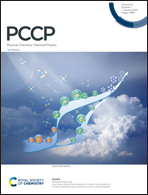The formation of active phases in Pt-containing catalysts for bicyclohexyl dehydrogenation in hydrogen storage†
Abstract
The fundamental role of the carbon carrier Sibunit® in the formation of active and selective phases in low-percentage Pt-containing catalysts Pt/C, Pt/Ni/C, Pt/Ni-Cr/C for the complete dehydrogenation of bicyclohexyl into biphenyl (320 °C, 1 atm) is shown. The Pt/Ni-Cr/C catalyst showed the greatest activity and selectivity in the complete dehydrogenation of bicyclohexyl into biphenyl. Detailed analysis of the catalyst surface by XPS, TEM-HR and EDX methods revealed two main processes associated with the high activity and successful course of the reaction of bicyclohexyl dehydrogenation: the formation of an active carbide Pt1−xCx phase and graphitization of the carbon carrier. Both these processes are realized equally in the Pt/Ni-Cr/C catalyst demonstrating the highest activity. The formation of the Pt1−xCx carbide phase at a low extent of graphitization of the catalyst surface is predominant for the Pt/C catalyst. Graphitization of the carbon carrier is most pronounced for Pt/Ni/C, where the yield of biphenyl is significantly reduced. The formation of graphite for the Pt/Ni/C catalyst at the metal–carrier interface leads to the encapsulation of a metal particle in a graphite shell, which apparently determines its low activity in the conversion of bicyclohexyl.



 Please wait while we load your content...
Please wait while we load your content...